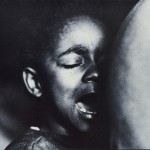Gordon Parks was an African American photographer who was born on a Kansas farm in 1912. Growing up in the early 1900s as the son of African American farmers allowed Parks to learn how to “value his parents’ hard work, compassion, integrity, and capacity for hope as well as to fear the brutality and perversity of personal and institutionalized racism” (Schul, 2008). His personal background has significant influence on the focus of his work, which often highlights the poverty, racism, and demoralization that lower class citizens face within society.
At the age of 15, Parks’ mother died, which resulted in him being sent to live with his sister and her husband in St. Paul, Minnesota. He was unable to finish high school because his brother-in-law kicked him out of the house. For the next ten years, he worked a series of low-paying jobs to support himself (Alexander, 2006). While working as a train station porter in 1937, Parks became interested in photography while viewing the discarded magazines of passengers (Alexander, 2006).
In 1937, he began his photography career with the purchase of a used camera at a pawnshop. After only a few months, his work was displayed in the storefront of Eastman Kodak in Minneapolis. When his work was viewed by Marva Louis — wife of heavy weight boxing champion, Joe Louis — she encouraged Parks to move to Chicago where he would have more opportunities to expand his career (Simmonds, 2010). His move to Chicago proved to broaden his opportunities. He became the first African American to be employed as a photographer by Vogue and Life magazine and also worked as a photo-journalist for both the Farm Security Administration (FSA) and the overseas division of the Office of War Information.
In 1967, Parks created a collection of photos called “A Harlem Family 1967.” The collection consisted of black and white photos that detailed daily routines of the Fontenelle family. He used a few of the photos from the collection for an article he wrote for Life Magazine that shed light on the living conditions and treatment of African Americans in northern ghettos. One of the photos was of five-year-old Ellen Fontenelle. This photograph was used as a cover for Life magazine and was accompanied by a desperate plea for change in the treatment of Blacks.
The child was photographed while wailing with her eyes closed and her mouth open as a tear rolled down her face. Along with the faded background, his use of light heightens the focus on her tear, magnifying her look of desperation. Her open mouth almost makes her wail audible. The photograph of the crying child heightens the impact of the photo collection’s theme, which brought more awareness to the plight of poverty-stricken African American families.
Bessie and Norman Fontenelle moved from the south to Harlem during the Great Migration in an attempt to seek employment in the booming northern factory industry. They thought the move would be a new beginning to a successful future but whenever they moved to Harlem, they were subjected to the same racism, demoralization, and employment issues that occurred in the South. The Fontanelles had 12 children; 10 of which lived with them in their tiny Harlem apartment.
After working for the same company for 11 years, Norman Fontenelle was laid off for no apparent reason. The family was left with no money, no food, and no winter clothes for the rapidly approaching winter months. Being unemployed with the responsibility of taking care of himself and his large family soon began to take a toll on Norman. He began to drink and take his anger out on his family which resulted in common domestic violence.
Even though the family made timely house payments, the landlord refused to fix any problems within the house. The Fontenelle residence was infested with roaches and rats which chewed holes through their walls and created drafts in the winter months. The family knew that if they missed a house payment, they would be kicked out of the house and quickly replaced with another desperate family so they did not complain too much.
The family rarely had enough to feed every individual. Sometimes a few of the siblings would share one apple or one cup of milk. The youngest child could not be stopped from eating plaster so his lips were always cracked and swollen. The family frequently ate half spoiled foods because it was all they could afford. For Thanksgiving, the family huddled around an open stove for heat while they ate sausage and eggs; being their most luxurious meal in months.
Parks’ photo of Ellen Fontenelle represents the desperation of many African American families along with the controversy over the effectiveness of the Great Migration. Blacks moved to the north for better opportunities but as their population increased, their situations worsened. Northern whites became intimidated by the newfound African American pride in themselves and their culture so they no longer wished to help them. The photo by Parks along with his magazine special allowed America and the rest of the world to be enlightened on the worsening condition of African Americans.
DAB
List of References
Alexander, S. (2006). Gordon Parks. United Kingdom: Black Filmmaker Publications Ltd.
Schul, Elizabeth. “Parks, Gordon.” The Concise Oxford Companion to African American Literature. Ed. William L. Andrews, Frances Smith Foster and Trudier Harris. New York: Oxford UP, 2008. Oxford African American Studies Center. Tue Jul 14 20:11:16 EDT 2015. <http://www.oxfordaasc.com/article/opr/t52/e447>.
Simmonds, Y. J. (2009, Aug). Gordon parks. Sentinel Retrieved from http:// search.proquest.com/docview/369277883?accountid=14244
Parks, G. (2012). Gordon Parks : a Harlem family 1967 (1st ed.). Göttingen, Germany: Steidl.
